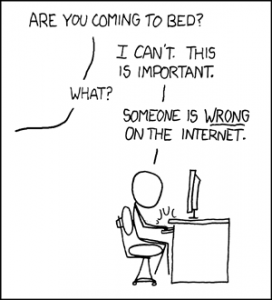
Arne Lewis, was my Art History professor and advisor. He combined a soft-spoken style with an intense curiosity about how people learn. I still remember his critique of my draft of my first chapter of what would be a hundred-page senior thesis. “There are a lot of provocative ideas here,” he said, “but I am not sure you want to discuss them.” “Why do you say that,” I asked, surprised. He read me several paragraphs, and then said, “It sounds to me as if you have finished thinking about everything you’ve written. You have all the answers. I haven’t found your invitation to the reader to join you in the thought process.”
When I had arrived as a college freshman, I found that most of my professors were lecturers. I felt as though every day I was assaulted by answers to questions I couldn’t imagine or at least had never asked. Arne Lewis was different, he taught with great questions and he appreciated great questions from his students. Arne was “calling me out” in his own gentle way. Knowing me well, he was reminding me of what I had really learned in four years – that learning is a fundamentally collaborative experience. He didn’t see it reflected in the way I had written that first chapter.
This was the beginning of the shift in my understanding of what being smart means. I had grown up thinking that smart people were the people who knew all the answers. In many cases, they had a lot of knowledge they wanted to share, but few friends with whom to share it. I asked Arne what I could do to write the chapter in a way that would engage the reader. He smiled and said, “Now that’s a really good question.” I came away from that discussion with three ideas that I continue to work on in my writing and communication to this day.
1. A story can be an invitation. A story can raise good questions in the mind of the reader or the listener even ones you hadn’t known were there. It can launch a shared experience. Collect stories and experiences that will help you frame new challenges and opportunities.
2. Master the “art of the tentative.” Let your language reflect the fact that you are still in the process of considering an idea and are open to other interpretations and insights. Sentences can begin with “It seems to me at this stage, given what we understand so far, that …” or “My limited experience to date suggests that …” or “The question that has me most puzzled is …” Tenatively set out some ideas. Then energize the conversation with questions rather than burying it in an avalanche of answers.
3. Keep the dialogue going even once a choice has been made. The “art of the tentative” doesn’t mean “analysis paralysis.” We often need to make choices even if we aren’t certain about all the answers. We can refine those choices and make mid-course corrections by continuing to engage smart people about what they are learning. This makes it all the more critical that we know what the important questions are.
In the age of mobile devices with Google search, the definition of what it means to be smart might have been turned upside down. We can find a lot of answers any time we need them if we are smart enough to know how to frame the questions.

4 responses to “Being Smart About Being Smart: Invite Others Into a Shared Thought Process”
This is so valuable, Giles.The mid-course corrections require courage and energy, at times more than the initial decision, and the input to make them comes from the open exchange with intelligent people around you… if you only engage them with real questions. I love your strategy blog. It prompts much needed reflections on our daily challenges.
Thanks so much for the encouragement. Glad you enjoy the blog. Good point about the mid-course corrections sometimes taking more courage than the initial decisons.
Giles, another great blog…. I look forward to your posts, and what I learn from them. I like the way you engage the reader sharing things you have learned from your life experiences!
Glad to hear from you and that you are enjoying the blog.